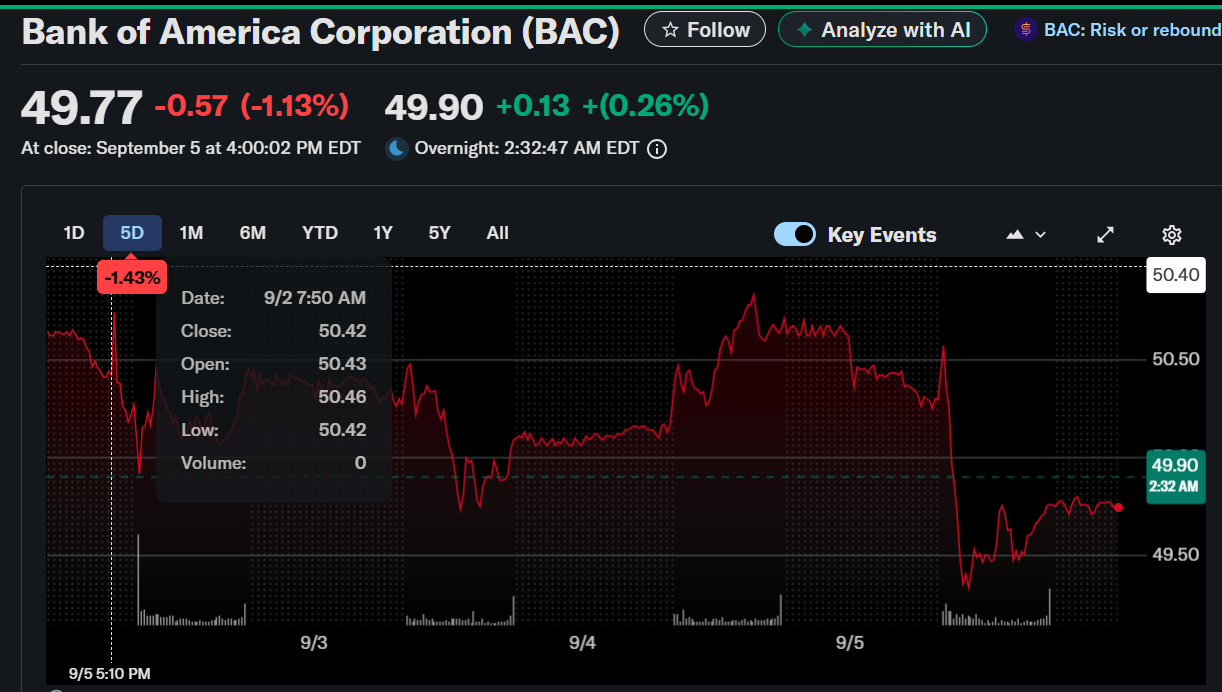TLDR
- Bank of America (BAC) closed at $49.77 on September 5, down 1.13%, with after-hours trading at $49.74.
- The bank launched its Alts Expanded Access Program to give ultra-wealthy clients more exposure to private markets.
- BAC shares are up more than 10% in the past month and 31% over the past year.
- Analysts highlight the stock as 14.8% overvalued based on long-term revenue and margin forecasts.
- Performance remains strong, with a 5-year total return of 111.82%, outpacing the S&P 500’s 89.13%.
Bank of America Corporation (NYSE: BAC), which closed at $49.77 on September 5, has unveiled a new offering for its wealthiest clients.

Bank of America Corporation (BAC)
Through Merrill Wealth Management and Bank of America Private Bank, the firm introduced the Alts Expanded Access Program. This initiative provides ultra-wealthy investors with broader access to private market funds and exclusive opportunities.
The move reflects rising demand among affluent clients for alternative investments outside of traditional equities and fixed income. It also underscores the bank’s strategy to enhance its wealth management services, a division critical to long-term growth.
Bank of America will offer investments in private equity funds to its ultra-wealthy clients, a move that comes as more financial firms give access in alternative assets to a broader swath of millionaires https://t.co/HggyraYtOq
— Bloomberg (@business) September 4, 2025
Stock Performance and Market Context
BAC stock has gained momentum, rising over 10% in the past month. On a one-year basis, total returns have reached 27.74%, while the broader S&P 500 posted 17.77%. The strong performance extends to long-term results, with a 5-year total return of 111.82%, compared to 89.13% for the index.
Despite this strength, shares slipped 1.13% on September 5 and edged down 0.05% after hours to $49.74, reflecting some caution among investors as valuation debates intensify.
Valuation Debate: 14.8% Premium
According to analysis, Bank of America stock is trading about 14.8% above fair value. Forecasts suggest net interest income could reach $62.5 billion by FY 2024, growing 2% annually, while non-interest revenue is projected to expand at 1.5% annually to $49.5 billion by FY 2030. Total revenue is expected to hit $112 billion by the end of the decade.
These projections assume steady economic conditions, stable margins, and favorable market trends. However, unexpected downturns or regulatory changes could derail this outlook, leading to sharper corrections in valuation.
Broader Strategy and Client Demand
The launch of the alternatives program fits into Bank of America’s broader strategy of meeting evolving client needs. Wealth management has become a key growth engine, with fixed-income offerings and workplace benefits research cited as tools for attracting and retaining customers. By expanding into private markets, the bank positions itself as a stronger partner for clients seeking diversification.
Performance Overview
As of September 5, Bank of America’s trailing returns highlight consistent gains:
- YTD return: 15.27% vs. S&P 500’s 10.20%.
- 3-year return: 61.17%, slightly below the index’s 65.16%.
- 5-year return: 111.82%, significantly above the S&P 500’s 89.13%.
These figures reflect both cyclical tailwinds and structural shifts in how investors view large financial institutions like Bank of America. With valuation questions emerging, investors will weigh whether current levels leave enough room for upside.






